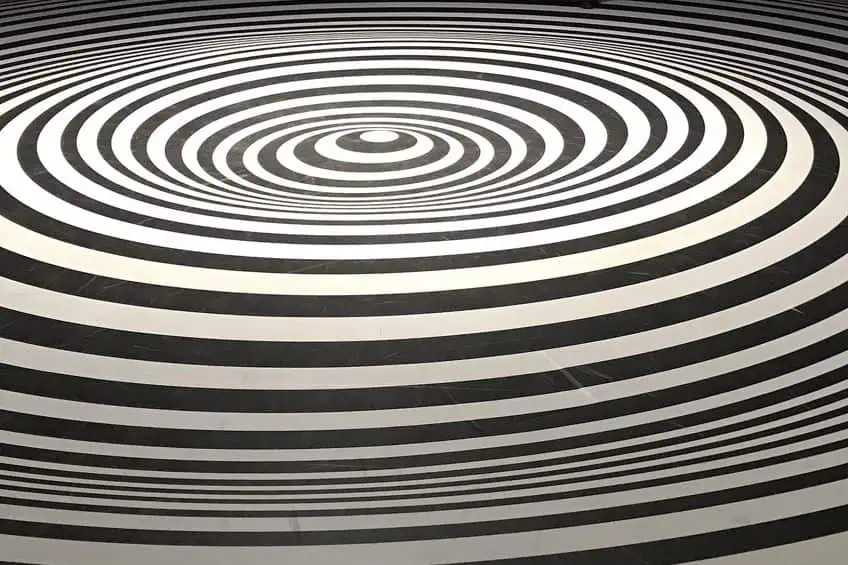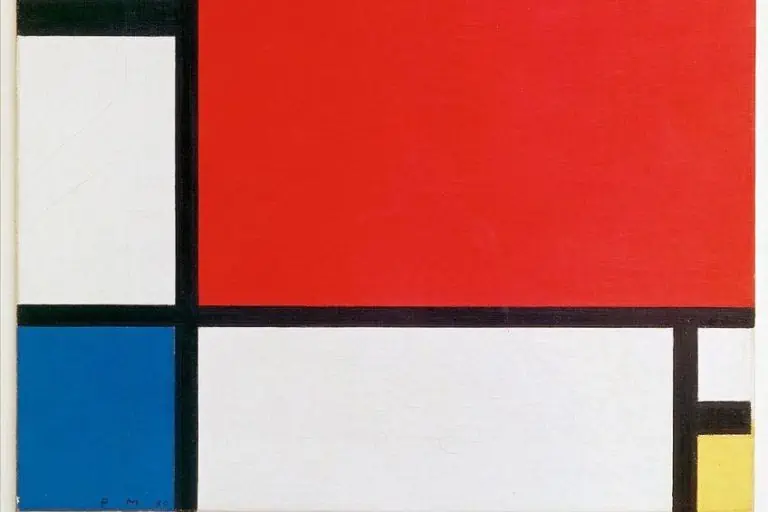Famous Op Art Artists – 10 Creatives Who Trick Our Eye
This post may contain affiliate links. We may earn a small commission from purchases made through them, at no additional cost to you.
In the mesmerizing world of visual arts, the realm of optical illusion takes center stage, captivating viewers with its beguiling interplay of form, color, and perception. In this article, we embark on an expedition through the annals of art history to explore the enchanting domain of famous Op art artists. From the iconic Op art examples that first emerged in the 1960s to the enduring legacy of renowned artists who harnessed the power of optical illusion, we delve into the works and artistic philosophies that have left an indelible mark on the world of famous Op art. Join us as we uncover the ingenious minds behind this transformative movement, and the mesmerizing creations that continue to inspire and challenge our visual senses.
Table of Contents
- 1 Getting to Know Famous Op Art Artists
- 1.1 M.C. Escher (1898 – 1972)
- 1.2 Victor Vasarely (1906 – 1997)
- 1.3 Carmen Herrera (1915 – 2022)
- 1.4 Peter Sedgley (1930 – Present)
- 1.5 Richard Anuszkiewicz (1930 – 2020)
- 1.6 Bridget Riley (1931 – Present)
- 1.7 Richard Allen (1933 – 1999)
- 1.8 Marina Apollonio (1940 – Present)
- 1.9 Richard Caldicott (1962 – Present)
- 1.10 Ara Peterson (1973 – Present)
- 2 Frequently Asked Questions
Getting to Know Famous Op Art Artists
Before we delve into the intricate works and intriguing lives of famous Op art artists, let’s first unravel the essence of Op art itself. Short for “optical art,” Op art is a fascinating genre that transcends the boundaries of traditional artistic expression. Rooted in the exploration of visual perception, Op art captivates audiences with its illusionary and often hypnotic compositions. These artworks are meticulously crafted to manipulate the viewer’s perception, evoking a sense of movement, depth, and sometimes even disorientation.
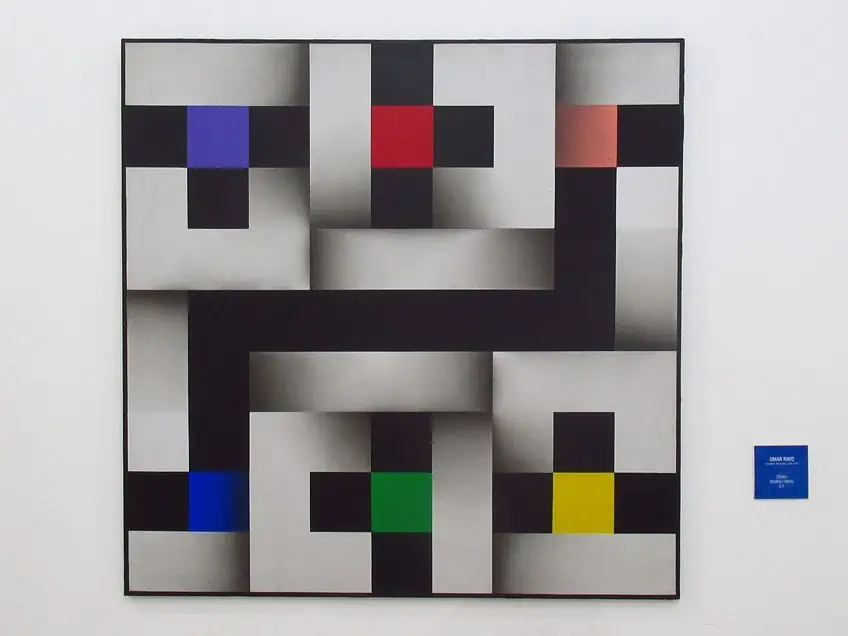 Santa Marta – Zibebiz (1994) by Omar Rayo; Felipe Restrepo Acosta, CC BY-SA 4.0, via Wikimedia Commons
Santa Marta – Zibebiz (1994) by Omar Rayo; Felipe Restrepo Acosta, CC BY-SA 4.0, via Wikimedia Commons
In this section we will embark on a captivating journey into the lives and artistry of the luminaries who have pushed the boundaries of this genre, shaping the very fabric of art history in the process. Each artist’s unique approach and visionary contributions have left an indelible mark on the world of art, offering us a profound glimpse into the limitless possibilities of the human imagination.
M.C. Escher (1898 – 1972)
| Date of Birth | 17 June 1898 |
| Date of Death | 27 March 1972 |
| Place of Birth | Leeuwarden, Netherlands |
| Nationality | Dutch |
| Art Movements | Op art and Modern art |
M.C. Escher, a true visionary in the realm of Op art, is celebrated for his remarkable contributions to the world of visual illusion and mathematical precision. Born in 1898, Escher’s artistic journey was characterized by a profound fascination with intricate tessellations, optical paradoxes, and impossible architectural structures.
His meticulously crafted lithographs and woodcuts transport viewers into surreal and mind-bending worlds, where reality is challenged at every turn.
Escher’s work delves into the intersection of art and mathematics, creating artworks that defy conventional notions of space and perspective. Through his dedication to pushing the boundaries of artistic expression, M.C. Escher has left an indelible mark on the art world, inspiring countless artists and enthusiasts with his profound exploration of the interplay between art and logic. His legacy endures as a testament to the enduring allure and intellectual depth of Op art.
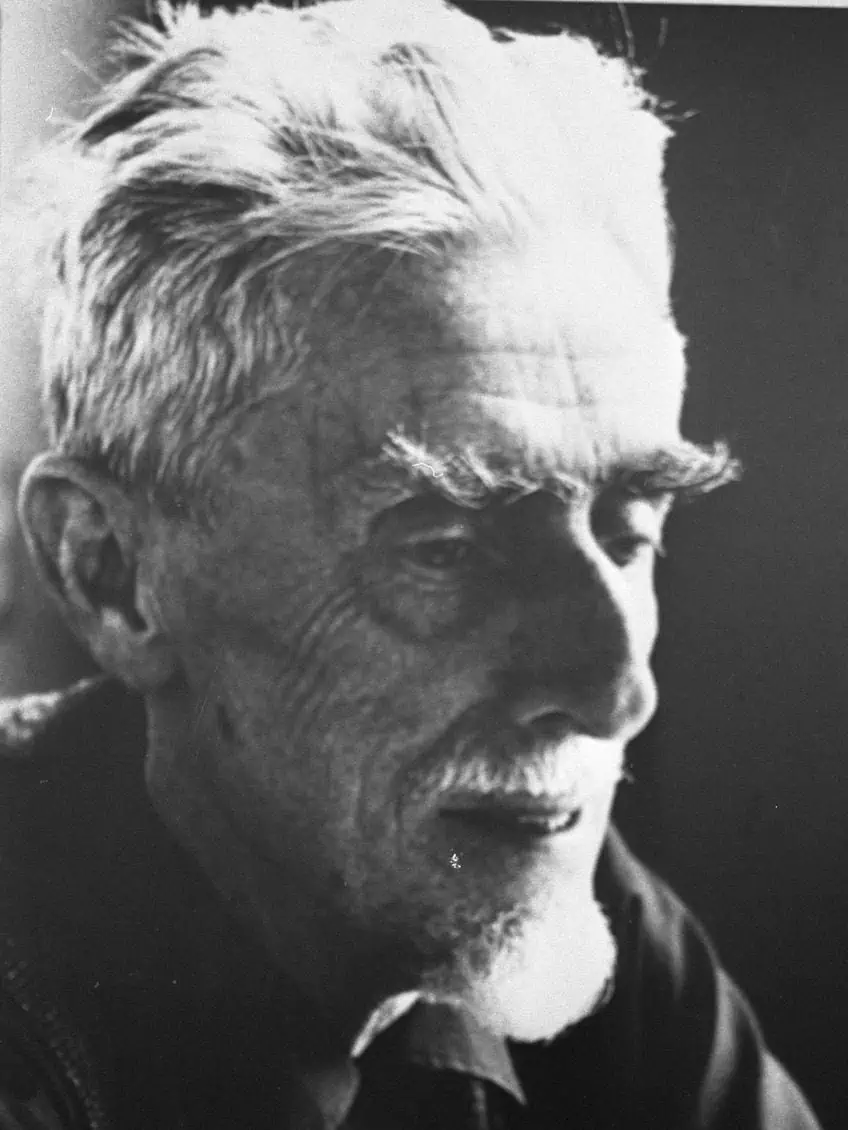 Photograph of Maurits (M.C.) Escher (1971) by Hans Peters; Photographer: Hans Peters (ANEFO), CC0, via Wikimedia Commons
Photograph of Maurits (M.C.) Escher (1971) by Hans Peters; Photographer: Hans Peters (ANEFO), CC0, via Wikimedia Commons
Visual and Conceptual Analysis of Day and Night (1938)
| Title | Day and Night |
| Date | 1938 |
| Medium | Woodcut |
| Dimensions (cm) | 39.2 x 67.6 |
| Location | University of Glasgow’s Hunterian Museum and Art Gallery, Glasgow, United Kingdom |
Escher’s most renowned print, produced in over 650 copies during his lifetime, features a captivating scene with a flock of birds soaring in opposite directions above a rural landscape. The town is meticulously mirrored on both sides of the image, with one side bathed in daylight and the other immersed in nighttime. The squares representing fields seamlessly transform into the birds, creating a mesmerizing tessellation as they interlock across the image’s top. This intricate composition masterfully blends elements of earth and sky, night and day, and various living creatures.
The checkerboard pattern of the fields harks back to 17th-century Dutch art, known for its dramatic perspective and distinctive black-and-white tiled floors.
Escher’s exploration of animals and tessellations extends into his broader body of work, where animals either tessellate across the entire image or transform into one another through interlocking designs and negative space. Notable examples include Lizard (1942) and Regular Division of the Plane (1938) for the former, and Sky and Water I (1938) for the latter. His inspiration for these works stemmed from his second visit to the Alhambra, a building that profoundly influenced him. Initially, he incorporated abstract geometrical elements observed at the Alhambra, but he gradually replaced them with stylized animal figures, as exemplified in this artwork.
Day and Night offers two distinct perspectives that seamlessly intertwine. The first perspective presents a bird’s-eye view, looking down upon the landscape below, while the second offers a direct, head-on view of the birds. Diagonal lines present in both the fields and the birds’ wings create a sense of upward movement and the direction of the birds’ flight, effectively erasing the boundary between foreground and background.
Victor Vasarely (1906 – 1997)
| Date of Birth | 9 April 1906 |
| Date of Death | 15 March 1997 |
| Place of Birth | Pécs, Hungary |
| Nationality | Hungarian-French |
| Art Movements | Op art, Modern art, Cubism, and Hard-edge painting |
Victor Vasarely, often hailed as the “grandfather of Op art,” stands as an artistic visionary who pioneered a revolution in the realm of visual perception. Born in Hungary in 1906, Vasarely’s journey from a young graphic designer to a globally celebrated artist is a testament to his unwavering dedication to pushing the boundaries of art.
His geometric compositions, characterized by precise lines, vibrant colors, and meticulously calibrated patterns, beckon viewers into a world of optical illusions and hypnotic motion.
With an unswerving commitment to exploring the infinite possibilities of form and perception, Vasarely’s oeuvre has left an enduring mark on the art world. His legacy extends beyond the canvas, as he sought to democratize art by making it accessible to all through his belief in “democratic multiple.” Victor Vasarely’s visionary creations continue to inspire artists and enthusiasts alike, resonating with the timeless allure of optical art.
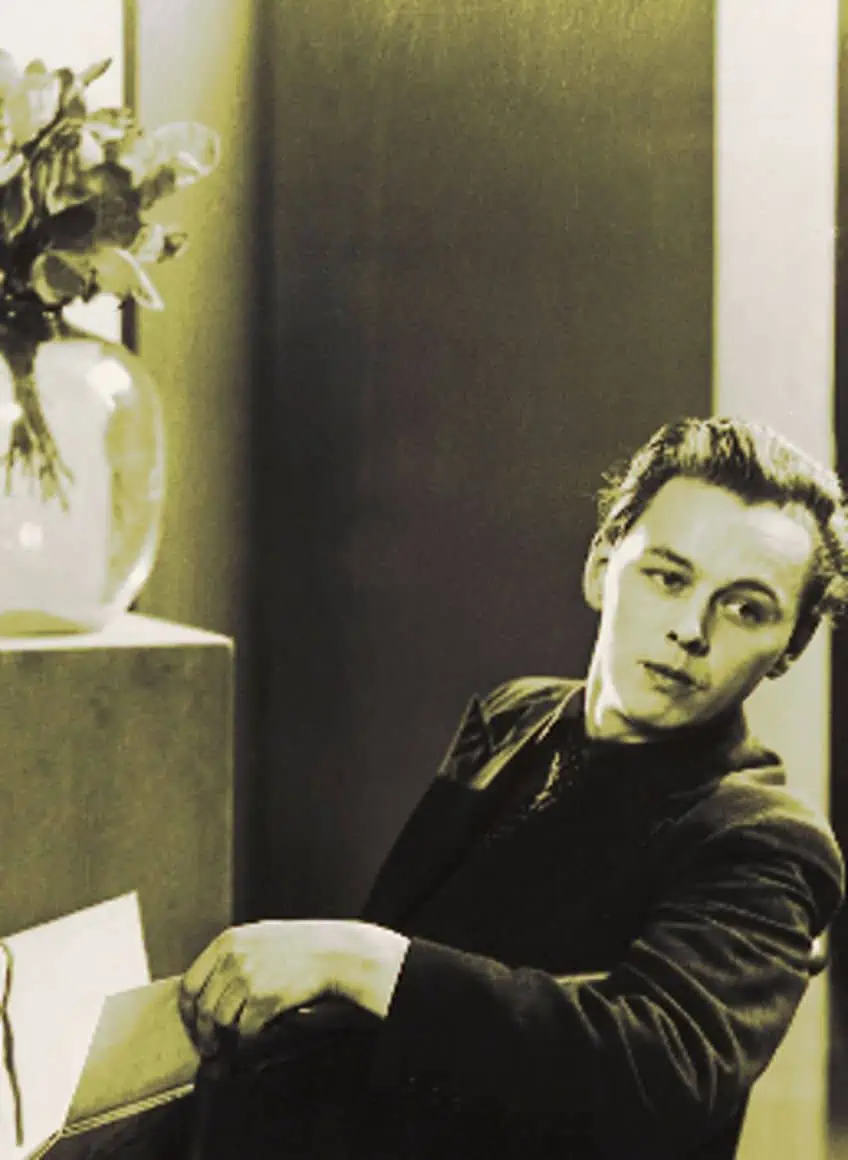 Victor Vasarely (1930); See page for author, Public domain, via Wikimedia Commons
Victor Vasarely (1930); See page for author, Public domain, via Wikimedia Commons
Visual and Conceptual Analysis of Zebra (1937)
| Title | Zebra |
| Date | 1937 |
| Medium | Acrylic on canvas |
| Dimensions (cm) | 52 x 60 |
| Location | Private collection |
Zebra serves as a quintessential exemplar of Op art’s groundbreaking exploration of geometric abstraction and optical illusions. The artwork’s meticulous composition, featuring alternating black and white stripes, showcases Vasarely’s keen mastery of form and balance. These stripes, when juxtaposed, create an active optical result that seems to throb and shudder, engaging the viewer in an immersive optical experience.
The stark contrast between the stripes enhances the artwork’s depth and dimensionality, blurring the boundaries between foreground and background.
Beyond its visual impact, Zebra delves into the conceptual realm of human perception. By using geometric designs and colors, Vasarely contests our sense of truth and asks his audience to question their own understanding of the gaze. The painting embodies a sense of rhythm and motion, as if the lines are in continuous flux, representing the core of life and motion. The title Zebra serves as an analogy for the ubiquitous codes of design and balance encountered in nature and the cosmos, transcending literal representation to explore the order and symmetry that underpins the universe.
Carmen Herrera (1915 – 2022)
| Date of Birth | 31 May 1915 |
| Date of Death | 12 February 2022 |
| Place of Birth | Havana, Cuba |
| Nationality | American, Cuban |
| Art Movements | Op art and Minimalism |
Carmen Herrera, a luminary in the world of Op art, left an indelible mark on the art world with her innovative and geometrically precise creations. Born in 1915, Herrera’s artistic journey spanned nearly a century, marked by unwavering dedication to the interplay of form, color, and abstraction. Her artwork often featured meticulously arranged shapes and lines, characterized by vibrant color combinations and a sense of geometric harmony.
Herrera’s unique ability to distill her compositions down to their most essential elements resulted in minimalist yet captivating artworks that challenged viewers to explore the depths of visual perception.
Her legacy is a testament to the enduring allure and innovation of Op art, inspiring generations of artists with her profound exploration of the relationship between art and geometry. Carmen Herrera’s contribution to the art world will continue to resonate for years to come, reflecting her timeless impact on contemporary art.
Visual and Conceptual Analysis of Untitled (1952)
| Title | Untitled |
| Date | 1952 |
| Medium | Synthetic polymer paint on canvas |
| Dimensions (cm) | 63.5 x 152.4 |
| Location | The Museum of Modern Art, New York City, United States |
In Untitled, Carmen Herrera employs black and white lines that traverse the canvas, cleaved by a jagged line, effectively dividing the composition into two sets of triangles. It’s a stark and almost forcefully minimalist image, where the precision of sharp edges creates an unexpected illusion of vibration and motion. Herrera appears to delve into the very process through which viewers decipher shapes and colors on the canvas, highlighting their active role in constructing the final image within their own minds.
This artwork draws clear inspiration from the post-war Op art movement, which, like Herrera’s own body of work, emerged from the post-1945 Parisian art scene, notably influenced by post-Constructivist circles.
Interestingly, Victor Vasarely, a Hungarian artist renowned for producing similar black-and-white optical art, was refining his distinctive style in Paris during Herrera’s time there, although any direct interaction between them remains undocumented. Nevertheless, akin to Vasarely, Herrera infuses her compositions, comprised solely of straight lines and blocks of monochromatic color, with a vibrant and almost enchanting energy. While Vasarely’s style was partly informed by scientific investigations into visual perception, Herrera’s Op-art-inspired works were born from practical experimentation and celebrated the potential of composition. As Herrera herself has stated, “There is nothing I love more than to make a straight line…It’s the beginning of all structures really.”
Peter Sedgley (1930 – Present)
| Date of Birth | 1930 |
| Age | 93 years old |
| Place of Birth | London, United Kingdom |
| Nationality | British |
| Art Movements | Kinetic and Op art |
Peter Sedgley, a prominent figure in the realm of Op art, is celebrated for his innovative and captivating explorations of visual perception. Born in 1930 in London, Sedgley’s artistic journey has been marked by a relentless pursuit of optical illusion and geometric abstraction.
His work often features meticulously arranged patterns, where color, form, and rhythm coalesce to produce mesmerizing visual effects.
Sedgley’s fascination with the interplay of light and color is evident in his creations, which seem to dance and shift before the viewer’s eyes, evoking a sense of movement and dynamism within the static canvas. Through his unwavering dedication to pushing the boundaries of art, Peter Sedgley has not only left an enduring mark on the Op art movement but also continues to inspire contemporary artists and enthusiasts alike with his immersive and thought-provoking compositions.
 Tile motif in Pimilco tube station (c. 1972) by Peter Sedgley; Ian Wright, CC BY-SA 2.0, via Wikimedia Commons
Tile motif in Pimilco tube station (c. 1972) by Peter Sedgley; Ian Wright, CC BY-SA 2.0, via Wikimedia Commons
Visual and Conceptual Analysis of Color Cycle III (1970)
| Title | Color Cycle III |
| Date | 1970 |
| Medium | Acrylic paint on canvas |
| Dimensions (cm) | 184,1 × 182,9 |
| Location | Tate Modern, London, United Kingdom |
In a dimly lit environment, a canvas ornamented with concentric circles, each flaunting a diverse array of hues, undergoes a remarkable transformation through a meticulously programmed sequence of shifting colored lights, resulting in a striking metamorphosis of colors. Peter Sedgley, in a letter from April 24, 1972, noted that the series Colour Cycle III forms a part of and Colour Cycle III shared a common thread – a dialogue between the illumination of colors and the painted surface. While they may not conform to a strict series, each artwork varies in size, color palette, lighting sequence, and complexity.
Colour Cycle III speaks of Sedgley’s artistic journey’s root: a fascination with movement.
The selection and arrangement of colors serve as a visual diaphragm, facilitating a wide range of color changes and structural movement akin to tuning a musical instrument. The lighting sequences become a visual score, allowing for chromatic development, counterpoint, crescendo, and more, with each composition being unique in duration and character.
Sedgley’s choice of materials, primarily PVA paint with occasional fluorescent additions, and the customization of control gear from various sources demonstrate his dedication to experimenting and pushing the boundaries of visual art through the interplay of light and color. He recognized that, amidst the inundation of visual stimuli in everyday life, the artist’s role is to explore new frontiers in vision and light to remain at the avant-garde of creative expression.
Richard Anuszkiewicz (1930 – 2020)
| Date of Birth | 23 May 1930 |
| Date of Death | 19 May 2020 |
| Place of Birth | Erie, Pennsylvania, United States |
| Nationality | American |
| Art Movements | Op art and Hard-edge painting |
Richard Anuszkiewicz, a luminary in the world of Op art, is celebrated for his groundbreaking contributions to the exploration of visual perception. Born in 1930, Anuszkiewicz’s career spans decades and has left an indelible mark on the art world. His meticulous geometric compositions, characterized by vibrant colors and precise arrangements, create optical illusions that captivate and challenge the viewer’s senses.
Anuszkiewicz’s work delves into the dynamic interplay of form, color, and light, producing artworks that appear to shift and pulsate before the observer’s eyes.
Through his unwavering dedication to pushing the boundaries of artistic expression, Richard Anuszkiewicz has redefined the very nature of visual art, offering a profound exploration of the relationship between art and perception. His legacy continues to inspire contemporary artists, serving as a testament to the enduring allure and innovation of Op art.
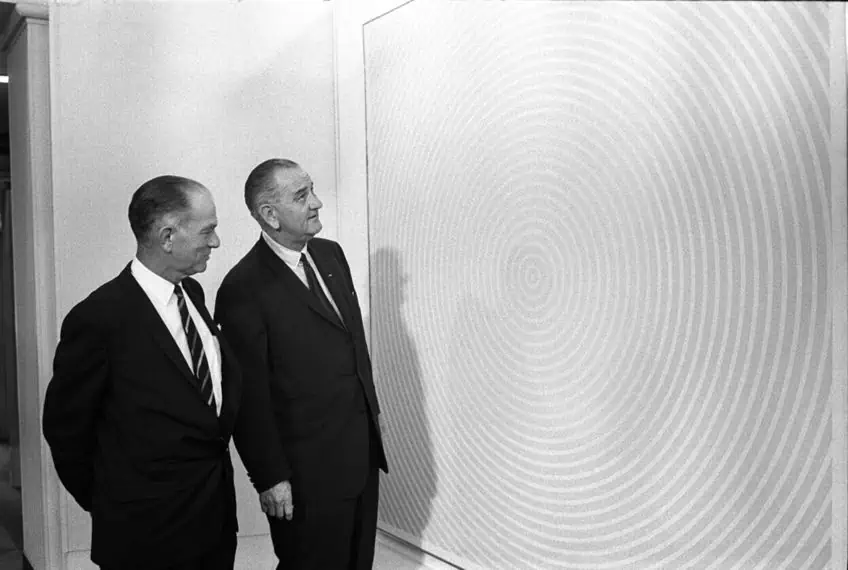 U.S. President Lyndon Baines Johnson and U.S. Senator J. William Fulbright inspect “Squaring the Circle”, a bright red 1963 painting by Richard Anuszkiewicz, at the 1965 White House Arts Festival (1965); Yoichi Okamoto, via Wikimedia Commons
U.S. President Lyndon Baines Johnson and U.S. Senator J. William Fulbright inspect “Squaring the Circle”, a bright red 1963 painting by Richard Anuszkiewicz, at the 1965 White House Arts Festival (1965); Yoichi Okamoto, via Wikimedia Commons
Visual and Conceptual Analysis of Knowledge and Disappearance (1961)
| Title | Knowledge and Disappearance |
| Date | 1961 |
| Medium | Oil on canvas |
| Dimensions (cm) | 127.3 × 124.6 |
| Location | The Philadelphia Museum of Art, Philadelphia, United States |
Knowledge and Disappearance, a sizable square artwork measuring approximately 50 by 50 inches, draws the observer into a dynamic space teeming with movement. It features alternating rectangles in warm red and cool gray, reminiscent of Vasarely’s contemporary style, creating an illusion of depth through the use of linear perspective. The rectangles within the central square gradually shrink toward its edges, generating a sensation of a convex, pulsating surface akin to a heart chamber.
Anuszkiewicz’s two-dimensional art often evokes a vivid physical presence, occasionally causing visual discomfort or disturbance.
Anuszkiewicz articulated his art using scientific terminology in line with the rationalist principles of Op art and Kinetic Art. He emphasized his exploration of the effects of juxtaposing complementary colors at full intensity and the optical transformations that ensue. Anuszkiewicz also delved into the dynamic interplay of the whole artwork under changing light conditions and the impact of light on color. These motivations have continued to propel his artistic journey. Knowledge and Disappearance received mixed reviews, reflecting its significant cultural impact.
Bridget Riley (1931 – Present)
| Date of Birth | 24 April 1931 |
| Age | 92 years old |
| Place of Birth | West Norwood, London, United Kingdom |
| Nationality | British |
| Art Movements | Op art, Modern art, and Hard-edge painting |
Bridget Riley, an iconic figure in the realm of Op art, is celebrated for her groundbreaking contributions to the exploration of optical illusions and perceptual experiences through art. Born in 1931, Riley’s illustrious career has spanned decades, leaving an indelible mark on the art world.
Her meticulous and precisely executed geometric compositions, characterized by vibrant colors and intricate patterns, create optical phenomena that challenge and captivate the viewer’s senses.
Riley’s work delves into the dynamic interplay of form, color, and spatial relationships, producing artworks that appear to shift and pulsate before the observer’s eyes. Through her unwavering dedication to pushing the boundaries of artistic expression, Bridget Riley has not only redefined the very nature of visual art but has also inspired generations of artists with her profound exploration of the relationship between art and perception. Her legacy endures as a testament to the enduring allure and innovation of Op art.
 Bolt of Colour (2017-2019) by Bridget Riley; Colmandavid, CC BY-SA 4.0, via Wikimedia Commons
Bolt of Colour (2017-2019) by Bridget Riley; Colmandavid, CC BY-SA 4.0, via Wikimedia Commons
Visual and Conceptual Analysis of Movement in Squares (1961)
| Title | Movement in Squares |
| Date | 1961 |
| Medium | Acrylic on canvas |
| Dimensions (cm) | 123.2 x 121.2 |
| Location | Arts Council Collection, London, United Kingdom |
In Riley’s artistic journey, Movement in Squares marked a significant breakthrough toward abstraction, following her earlier work “Kiss.” Faced with creative challenges, she embarked on a new artistic direction by starting with the elementary square shape. Riley noted that everyone recognizes and understands the square’s geometric characteristics, making it a stable and symmetrical form with equal angles and sides. Initially, drawing squares did not yield any remarkable revelations. However, as she continued sketching, something transformative unfolded. In one continuous session, she conceived the design for Movement in Squares without interruption, subsequently alternating the squares with black ones to create contrast.
Stepping back to assess her work, Riley was both surprised and exhilarated by the result.
In Movement in Squares, Riley establishes the square as the fundamental unit and then modulates it across the canvas, maintaining its height while altering its width. The squares’ width gradually narrows toward the canvas’s center, forming a slender shape, and then widens again toward the right edge. This transformation appears as though two planes are converging and curving into each other, akin to the pages of an open book. The progression of shapes intensifies, reaches a climax, and then diminishes, challenging viewers to confront their perceptions and notions of stability, instability, certainty, and uncertainty. Riley’s exploration of the mechanics of vision was rooted in her personal experiences, experimentation, and intuition, rather than relying on established optical theories.
Richard Allen (1933 – 1999)
| Date of Birth | 8 February 1933 |
| Date of Death | 9 February 1999 |
| Place of Birth | Worcester, United Kingdom |
| Nationality | British |
| Art Movements | Minimalism, Abstract art, Systems art, Fundamental art, Op art, and Geometric art |
Richard Allen, a distinguished figure in the realm of Op art, is celebrated for his pioneering contributions to the exploration of optical illusions and geometric abstraction. Hailing from England, Allen’s artistic journey is marked by his unwavering dedication to the interplay of form, color, and perception.
His work often features meticulously arranged patterns and shapes, meticulously designed to challenge and captivate the viewer’s visual senses.
Through a meticulous and calculated approach, Allen’s art has the power to evoke a sense of movement and dynamism within the static canvas, all while encouraging viewers to question their perception of reality. Richard Allen’s legacy continues to inspire contemporary artists, serving as a testament to the enduring allure of Op art and its capacity to challenge and redefine our visual experiences.
Visual and Conceptual Analysis of Untitled Systems (1972)
| Title | Untitled Systems |
| Date | 1972 |
| Medium | Polyvinyl acetate on six canvases |
| Dimensions (cm) | 106,7 × 213,6 |
| Location | Tate Modern, London, United Kingdom |
In Richard Allen’s Untitled Systems, we encounter a captivating example of Op art’s mastery of visual perception. The canvas is a mesmerizing interplay of geometric forms and vibrant colors, meticulously arranged to create an illusion of depth and movement. The vertical lines seem to form a zig-zag pattern, tricking your eyes into believing that the artist actually painted triangular shapes.
Allen’s precision in executing these optical effects is remarkable, as the artwork challenges our sense of stability and reality.
Conceptually, Untitled Systems exemplifies the Op art movement’s exploration of the basic way humans view the world. By manipulating patterns and colors, Allen prompts viewers to question the reliability of their visual senses. The artwork blurs the line between what is seen and what is inferred, inviting contemplation of the very essence of reality itself. Richard Allen’s Untitled Systems is a testament to the transformative power of Op art, leaving an enduring impression on those who experience its mesmerizing visual and conceptual complexities.
Marina Apollonio (1940 – Present)
| Date of Birth | 12 November 1940 |
| Age | 82 years old |
| Place of Birth | Trieste, Italy |
| Nationality | Italian |
| Art Movements | Kinetic and optical art |
Marina Apollonio, a visionary artist known for her groundbreaking contributions to the realm of kinetic and optical art, has left an indelible mark on the art world. Born in 1940 in Italy, Apollonio’s career is a testament to her pioneering spirit and innovative artistic approach. Her work often blurs the lines between art and science, exploring the interplay of light, motion, and perception.
Through meticulously crafted kinetic sculptures and optical installations, she engages viewers in a dynamic and immersive visual experience.
Apollonio’s dedication to pushing the boundaries of artistic expression has not only redefined the concept of art but has also challenged our understanding of the relationship between art and technology. With a career spanning several decades, Marina Apollonio continues to inspire and influence contemporary artists, captivating audiences with her profound exploration of the intersection between art and science.
 Marina Apollonio, Circular Dynamics 4S, 1968/2019 at Mumok, Vienna (2019); Alzen, CC BY-SA 4.0, via Wikimedia Commons
Marina Apollonio, Circular Dynamics 4S, 1968/2019 at Mumok, Vienna (2019); Alzen, CC BY-SA 4.0, via Wikimedia Commons
Visual and Conceptual Analysis of Relief No. 505 (1968)
| Title | Relief No. 505 |
| Date | 1968 |
| Medium | Aluminum and fluorescent paint on Masonite |
| Dimensions (cm) | 49.9 x 49.8 |
| Location | Peggy Guggenheim Collection, Venice, Italy |
In Relief No. 505, one of Marina Apollonio’s renowned Op art sculptures, geometric shapes and lines converge to create a mesmerizing visual symphony. Her meticulous precision and dedication to the optical art movement are evident as the composition pulsates with rhythmic intensity.
Vibrant colors interact harmoniously, forming a dynamic visual medley that appears to vibrate and oscillate, captivating the viewer’s attention.
Beyond its hypnotic visual effects, Relief No. 505 invites the meditation of what we see- forcing a moment of quiet reflection. It challenges our sense of reality, prompting us to question the boundaries between what we see and what our minds interpret. Through her artistic mastery, Marina Apollonio’s Op art sculpture surpasses the artwork itself, offering a deep questioning of the human understanding and the endless opportunities of optical art.
Richard Caldicott (1962 – Present)
| Date of Birth | 1962 |
| Age | 61 years old |
| Place of Birth | Leicester, United Kingdom |
| Nationality | British |
| Art Movements | Op art, Modern art, Cubism, and Abstract art |
Richard Caldicott, a contemporary artist of remarkable distinction, navigates the intersection of photography and abstract art with profound finesse. Born in 1962 in London, Caldicott’s work is a testament to his innovative approach to image-making. Through his masterful manipulation of color, shape, and composition, he transcends the boundaries of traditional photography, crafting captivating abstract pieces that border on the sublime.
Caldicott’s oeuvre often revolves around geometric abstraction, featuring vibrant, meticulously arranged forms that draw the viewer into a world of visual intrigue.
His exploration of light and shadow, coupled with his dedication to precision and craftsmanship, lends a unique and contemporary perspective to the realm of abstract art. With a career spanning decades, Richard Caldicott’s work continues to captivate art enthusiasts, offering a compelling glimpse into the limitless possibilities of abstract photography.
Visual and Conceptual Analysis of Untitled 176 (2000)
| Title | Untitled 176 |
| Date | 2000 |
| Medium | Photography |
| Dimensions (cm) | 127 x 101.6 |
| Location | Unknown |
In Untitled 176, geometric forms dance across the composition in a symphony of bright warm colors and. Vivid and harmonious, this photo work captures the essence of optical illusion and abstraction. Caldicott skillfully manipulates shapes, lines, and colors to create an exhilarating visual experience.
The composition appears to shift and ripple, engaging the viewer’s perception with its dynamic interplay of form and space.
Beyond its captivating visual effects, Caldicott’s artwork prompts a deeper exploration of the nature of perception itself. It challenges our prejudices, inviting us to question the boundaries between reality and abstraction. Through his meticulous craftsmanship and visionary approach, Richard Caldicott’s Op art photograph transcends the print, leaving a lasting impression on those fortunate enough to encounter it.
Ara Peterson (1973 – Present)
| Date of Birth | 1973 |
| Age | 50 years old |
| Place of Birth | Boston, Massachusetts, United States |
| Nationality | American |
| Art Movements | Op art and Geometric art |
Ara Peterson, a prominent figure in the realm of Op art, stands as a contemporary visionary celebrated for his innovative contributions to the genre. Born with a deep-rooted passion for geometric abstraction and optical illusions, Peterson’s artistic journey is marked by meticulous craftsmanship and an unwavering dedication to the interplay of form, color, and perception.
His work often features intricately designed patterns and shapes that dance and shift before the viewer’s eyes, creating a dynamic and immersive visual experience.
Ara Peterson’s distinctive approach challenges the boundaries of traditional artistic expression, encouraging viewers to explore the profound nuances of visual perception. His enduring impact on the world of Op art continues to inspire contemporary artists, showcasing the timeless allure of optical art and its potential to captivate and redefine our visual experiences.
Visual and Conceptual Analysis of Untitled (2012)
| Title | Untitled |
| Date | 2012 |
| Medium | Wood and acrylic paint |
| Dimensions (cm) | 122 x 243 x 10 |
| Location | Unknown |
In Ara Peterson’s celebrated Untitled Op art creation, we find ourselves fully immersed in a bewitching domain of geometric forms and optical misconceptions. Peterson’s particular attention to detail becomes apparent as intricate wave patterns and individually cut shapes that converge to form a scuplture that looks alive and moving.
The composition seems to be humming, trickling, and rippling, thereby mimicking the hypnotic movements of the ocean. Beyond its beguiling visual magnetism, Peterson’s artwork serves as a catalyst for profound introspection into the very essence of human perception – how can wood look like water? It compels us to challenge our conventional understanding of actuality, inviting us to query the boundaries that separate what our eyes perceive from what our minds interpret.
In conclusion, in the domain of famous Op art, the artists discussed in this article are proof of the enduring allure and innovative spirit of this influential art movement. From Victor Vasarely’s groundbreaking creations to Bridget Riley’s mesmerizing Op art examples, these artists have consistently challenged the boundaries of visual perception. Their meticulous use of geometric forms, vibrant colors, and optical illusions has not only captivated viewers but also inspired countless artists across the globe. As famous Op art continues to influence contemporary art, its legacy lives on, reminding us of the power of art to engage, mystify, and push the boundaries of what we perceive as reality.
Frequently Asked Questions
What Are the Types of Op Art?
Op art encompasses various types and approaches within its visual vocabulary. Some of the key types of Op art include geometric abstraction, where artists employ precise shapes and patterns to create optical illusions, kinetic art, which introduces movement and change to engage the viewer’s perception actively, and trompe-l’oeil, where artists simulate three-dimensional depth on a flat surface. Additionally, artists often explore the interplay of color, line, and form to challenge viewers’ visual experiences and provoke contemplation. These diverse approaches within Op art showcase the movement’s versatility and capacity to captivate and mystify through various techniques and styles.
Who Was the Grandfather of Op Art?
The title of the Grandfather of Op art is often attributed to Victor Vasarely, a Hungarian-French artist who made pioneering contributions to the Op art movement. Vasarely’s geometric and optical creations in the mid-20th century laid the foundation for the Op art movement, characterized by its use of precise shapes, patterns, and optical illusions to engage and challenge viewers’ perceptions. His innovative works served as an inspiration and catalyst for subsequent generations of Op artists, solidifying his legacy as a central figure in the development of this influential art movement.
Who Were the Artists in the Op Art of the 1960s?
The 1960s were a pivotal decade for Op art, and several prominent artists emerged during this period. Some of the notable Op artists from the 1960s include Bridget Riley, Victor Vasarely, Richard Anuszkiewicz, Julian Stanczak, and Carlos Cruz-Diez. These artists, among others, created works characterized by precise geometric forms, optical illusions, and vibrant color combinations, which pushed the boundaries of visual perception. Their innovative contributions defined the Op art movement during this era and continue to influence contemporary art today.
In 2005, Charlene completed her wellness degrees in therapeutic aromatherapy and reflexology at the International School of Reflexology and Meridian Therapy. She worked for a company offering corporate wellness programs for several years before opening her own therapy practice. In 2015, she was asked by a digital marketer friend to join her company as a content creator, and it was here that she discovered her enthusiasm for writing. Since entering the world of content creation, she has gained a lot of experience over the years writing about various topics such as beauty, health, wellness, travel, crafting, and much more. Due to various circumstances, she had to give up her therapy practice and now works as a freelance writer. Since she is a very creative person and as a balance to writing likes to be active in various areas of art and crafts, the activity at acrylgiessen.com is perfect for her to contribute their knowledge and experience in various creative topics.
Learn more about Charlene Lewis and about us.
